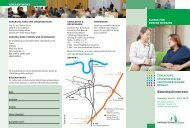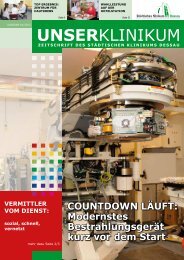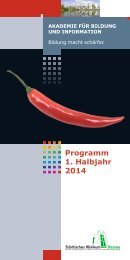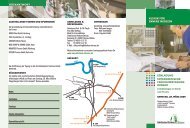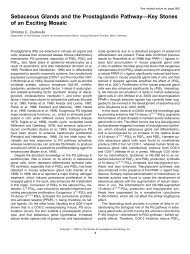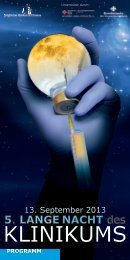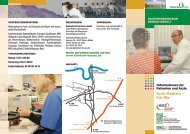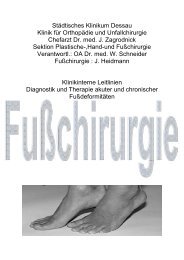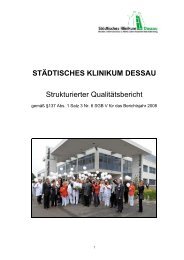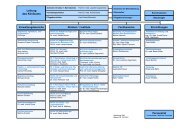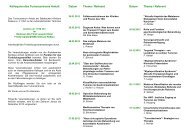Extracorporeal Photopheresis of Cutaneous T-Cell Lymphoma Is ...
Extracorporeal Photopheresis of Cutaneous T-Cell Lymphoma Is ...
Extracorporeal Photopheresis of Cutaneous T-Cell Lymphoma Is ...
You also want an ePaper? Increase the reach of your titles
YUMPU automatically turns print PDFs into web optimized ePapers that Google loves.
Clinical and Laboratory Investigations<br />
Dermatology 1998;196:305–308<br />
Received: July 23, 1997<br />
Accepted: November 10, 1997<br />
a<br />
b<br />
Ch.C. Zouboulis a<br />
M. Schmuth a<br />
S. Doepfmer b<br />
E. Dippel a<br />
C.E. Orfanos a<br />
Department <strong>of</strong> Dermatology and<br />
Institute <strong>of</strong> Medical Statistics,<br />
University Medical Center<br />
Benjamin Franklin,<br />
The Free University <strong>of</strong> Berlin, Germany<br />
<strong>Extracorporeal</strong> <strong>Photopheresis</strong> <strong>of</strong><br />
<strong>Cutaneous</strong> T-<strong>Cell</strong> <strong>Lymphoma</strong> <strong>Is</strong><br />
Associated with Reduction <strong>of</strong><br />
Peripheral CD4+ T Lymphocytes<br />
Key Words<br />
<strong>Extracorporeal</strong> photopheresis<br />
<strong>Cutaneous</strong> T-cell lymphoma<br />
Lymphocyte subpopulations<br />
Abstract<br />
Background: <strong>Extracorporeal</strong> photopheresis (ECP) has been successfully introduced<br />
for the treatment <strong>of</strong> cutaneous T-cell lymphoma; however, the mechanism(s)<br />
<strong>of</strong> its action is (are) unknown. Objective: To investigate the effects <strong>of</strong><br />
ECP on the immune system <strong>of</strong> patients with cutaneous T-cell lymphoma. Methods:<br />
Clinical response and changes <strong>of</strong> lymphocyte subpopulations in 20 patients<br />
with cutaneous T-cell lymphoma under ECP monotherapy or combined regimens<br />
were evaluated and compared after 3, 6 and 12 ECP cycles. Results: Thirteen<br />
<strong>of</strong> 20 patients showed a ≥50% reduction <strong>of</strong> skin lesions after 6–12 ECP cycles.<br />
An overall T-lymphocyte reduction was assessed with a balanced CD4+<br />
T-helper and CD8+ T-suppressor cell decrease in responders. In contrast, there<br />
was a trend <strong>of</strong> CD4+ T-helper cell increase in nonresponders which could result<br />
from the failure <strong>of</strong> treatment to control the natural course <strong>of</strong> the disease. The<br />
CD4+/CD8+ ratios were 1.6 at baseline and 1.4 after 12 cycles in responders,<br />
while they increased from 1.7 to 4.1 in nonresponders, respectively (p=0.047).<br />
In addition, there was an overall decrease in the CD57+/CD8+ T-cell subpopulation<br />
mostly due to a reduction in the responder group. Conclusion: The<br />
marked differences detected in certain T-cell subpopulations suggest an effect <strong>of</strong><br />
ECP on peripheral T lymphocytes and, especially, on CD4+ cells.<br />
oooooooooooooooooooo<br />
<strong>Extracorporeal</strong> photopheresis (ECP) has been successfully<br />
introduced for the treatment <strong>of</strong> erythrodermic cutaneous<br />
T-cell lymphoma [1–3]. Regimens combining ECP<br />
with interferon α (IFN-α), psoralen photochemotherapy<br />
and/or radiation were also successful in patients with tumor<br />
stage cutaneous T-cell lymphoma and lymph node involvement<br />
[4]. In addition to the clinical improvement a longterm,<br />
disease-free remission could be induced by ECP in a<br />
minority <strong>of</strong> patients [5]. The almost complete clearing <strong>of</strong><br />
skin lesions and the marked diminution <strong>of</strong> extensive lymphadenopathy<br />
in a patient with rapidly advancing Sézary syndrome<br />
treated with a combination <strong>of</strong> ECP and low-dose<br />
IFN-α was followed by disappearance <strong>of</strong> the malignant<br />
T-cell clone from the peripheral blood documented by<br />
Southern blot analysis [6]. The mechanisms <strong>of</strong> action underlying<br />
the favorable clinical results <strong>of</strong> ECP still remain to<br />
be elucidated.<br />
Ultraviolet A irradiation <strong>of</strong> peripheral blood enriched by<br />
8-methoxypsoralen was shown to induce apoptosis in malignant<br />
lymphocytes from patients with cutaneous T-cell<br />
Fax+41 61 306 12 34<br />
E-Mail karger@karger.ch<br />
www.karger.com<br />
© 1998 S. KargerAG, Basel<br />
1018–8665/98/1963–0305$15.00/0<br />
This article is also accessible online at:<br />
http://BioMedNet.com/karger<br />
Priv.-Doz. Dr. Christos C. Zouboulis<br />
Department <strong>of</strong> Dermatology, University Medical Center Benjamin Franklin<br />
Hindenburgdamm 30, D–12200 Berlin (Germany)<br />
Tel. +49 30 8445 2769, Fax +49 30 8445 4262<br />
E-Mail zoubbere@zedat.fu-berlin.de
Table 1. Diagnosis and treatment <strong>of</strong><br />
patients with cutaneous T-cell lymphoma<br />
during ECP therapy<br />
Patients Diagnosis Treatment Result <strong>of</strong><br />
and stage<br />
ECP treatment<br />
1 MF-II ECP (12 cycles)/IFN-α response<br />
2 MF-II ECP (12 cycles)/IFN-α nonresponse<br />
3 MF-II ECP (12 cycles)/IFN-α response<br />
4 MF-IV ECP (12 cycles) response<br />
5 MF-IV ECP (12 cycles) nonresponse<br />
6 MF-IV ECP (12 cycles) nonresponse<br />
7 MF-IV ECP (6 cycles)/IFN-α/PUVA response<br />
8 MF-IV ECP (6 cycles)/IFN-α nonresponse<br />
9 MF-IV ECP (12 cycles)/PUVA nonresponse<br />
10 MF-IV ECP (12 cycles)/IFN-α/acitretin response<br />
11 MF-V ECP (12 cycles)/IFN-α/polychemotherapy nonresponse<br />
12 MF-IV ECP (12 cycles)/IFN-α response<br />
13 MF-IV ECP (12 cycles)/PUVA response<br />
14 MF-IV ECP (6 cycles)/PUVA/irradiation response<br />
15 MF-IV ECP (12 cycles) response<br />
16 MF-IV ECP (12 cycles)/IFN-α response<br />
17 MF-IV ECP (12 cycles)/PUVA response<br />
18 SS ECP (6 cycles) nonresponse<br />
19 SS ECP (12 cycles) response<br />
20 SS ECP (12 cycles) response<br />
MF = Mycosis fungoides; SS = Sézary syndrome.<br />
lymphoma [7]. Simple photodestruction <strong>of</strong> circulating malignant<br />
lymphocytes may, however, not be the only explanation<br />
for the beneficial effect <strong>of</strong> ECP in cutaneous T-cell<br />
lymphoma, since ECP is also effective in other immunological<br />
cutaneous diseases [5].<br />
In order to further elucidate the effects <strong>of</strong> ECP on the<br />
immune system we have investigated the changes <strong>of</strong> lymphocyte<br />
subpopulations in patients with cutaneous T-cell<br />
lymphoma under therapy.<br />
Patients and Methods<br />
Twenty patients with the diagnosis <strong>of</strong> cutaneous T-cell lymphoma<br />
(14 males, 6 females; median age 61.5 years, range 31–93 years) were<br />
included in the study (table 1). All patients were shown to be HTLV-1<br />
negative. Evaluation <strong>of</strong> disease status included histological examination<br />
<strong>of</strong> skin biopsies, peripheral lymph nodes and bone marrow aspirates.<br />
All patients were treated on two consecutive days at approximately<br />
4-week intervals and completed at least 6 cycles <strong>of</strong> ECP; in 16<br />
patients, 12 cycles had been completed. Twenty milliliters <strong>of</strong> heparinized<br />
peripheral blood were collected before initiation <strong>of</strong> treatment<br />
and at day 1 prior to the 3rd, 6th and 12th ECP cycle. Mononuclear<br />
cells including monocytes were separated from 20 ml heparinized peripheral<br />
blood by using a Ficoll-Hypaque ® density gradient. Lymphocyte<br />
subpopulations were determined by indirect immun<strong>of</strong>luorescence<br />
using a battery <strong>of</strong> murine monoclonal antibodies in a Becton<br />
Dickinson FACSscan analyzer. <strong>Cell</strong> numbers were calculated as<br />
absolute cell counts per microliter <strong>of</strong> peripheral blood. Results were<br />
presented as median values <strong>of</strong> the absolute baseline cell numbers and<br />
as medians <strong>of</strong> change from baseline over time in order to avoid artificial<br />
changes <strong>of</strong> the absolute median values over time due to the reduced<br />
number <strong>of</strong> cases. Statistical analysis was performed using the<br />
Wilcoxon signed rank test for matched pairs <strong>of</strong> observations, comparing<br />
the 3rd, 6th and 12th treatments with baseline. Differences were<br />
considered to be significant when p
Table 2. Absolute baseline lymphocyte numbers (medians) and changes from baseline (medians <strong>of</strong> change) over time in patients with cutaneous<br />
T-cell lymphoma responding and nonresponding to ECP<br />
Before treatment After 3 ECP cycles After 6 ECP cycles After 12 ECP cycles<br />
responders nonresponders responders nonresponders responders nonresponders responders nonresponders<br />
(n = 13) (n = 7) (n = 13) (n = 6) (n = 13) (n = 6) (n = 11) (n = 5)<br />
Total lymphocytes 1,805 2,432 –472 –360 –362 –31 –552 +650<br />
(n = 7) (n = 7)<br />
T lymphocytes 1,227 2,019 –425 –509 –286 –419.5 –328 +478<br />
CD4+ T-helper cells 928 1,046 –157 –121.5 –101 –396 –258 +456<br />
CD8+ T-suppressor cells 534 309 –98 –19 –90 –95.5 –111 0<br />
CD4+/CD8+ ratio 1.60 1.70 +0.10 +1.05 –0.10 +3.70 –0.20 +2.40<br />
(p=1.000) (p=0.726) (p=0.096) (p=0.047)<br />
CD3+/HLA-DR+ 136 222 –63 –35 +11 +465.5 +2 +133<br />
activated T cells<br />
CD57+/CD8– NK cells 70 78 –34 +31 –39 –20.5 –18 +149<br />
(p=0.035)<br />
CD57+/CD8+ NK cells 136 113 –50 +9 –67 –66 –60 0<br />
CD4+/LECAM-1+ 82 141 –5 +21.5 –12 +377.5 –28 +181<br />
T-helper cells<br />
B lymphocytes 110 49 +6 –15.5 –48 –4.5 –16 –11<br />
Statistical analysis was performed using the Mann-Whitney U Wilcoxon rank sum test for independent samples. If not indicated, p values were >0.05.<br />
tients without clinical improvement (nonresponders) 4 were<br />
male and 3 were female (median age 62 years, range<br />
57–74).<br />
By evaluating the absolute numbers <strong>of</strong> lymphocyte subpopulations<br />
in all patients during the course <strong>of</strong> ECP treatment,<br />
a significant reduction <strong>of</strong> T lymphocytes was found<br />
after 3 ECP cycles (–32.8%; p=0.042). This reduction<br />
also persisted over the 6th (–22.1%) and the 12th cycle<br />
(–25.1%), although no statistical significance was found<br />
after prolonged treatment. The CD57+/CD8+ T-cell subpopulation,<br />
representing 10% <strong>of</strong> the total T-lymphocyte<br />
counts, was also found reduced after ECP: it decreased<br />
from –35.4% after 3 cycles (p=0.042) to –51.5% after 6<br />
cycles (p=0.011) and –40.4% after 12 cycles (n.s.). In the<br />
other lymphocyte subpopulations, such as CD4+ T-helper,<br />
CD4+/LECAM-1– T-helper, CD8+ T lymphocytes, activated<br />
T cells (CD3+/HLA-DR+), CD57+/CD8– natural<br />
killer cells and B lymphocytes, no significant changes were<br />
detected.<br />
By comparing the responder and nonresponder groups,<br />
there were trends <strong>of</strong> reduced CD4+ and CD8+ T-cell counts<br />
in responders (–27.8 and –20.8%, respectively, after 12 cycles)<br />
and CD4+ T-cell increase in nonresponders (+43.8%<br />
after 12 cycles). These changes were supported by differences<br />
<strong>of</strong> the CD4+/CD8+ ratios: 1.6 at baseline and 1.4<br />
after 12 cycles in responders, 1.7 at baseline and 4.1 after<br />
12 cycles in nonresponders (p=0.047). The CD57+/CD8+<br />
T-cell subpopulation <strong>of</strong> responders decreased by –36.8 to<br />
–49.3% during ECP treatment, whereas there was no clear<br />
change in nonresponders (+8.0 to –58.4%) and no significant<br />
differences could be calculated. No differences on the<br />
lymphocyte subpopulations were assessed regarding application<br />
<strong>of</strong> a concomitant medication, e.g. comparing ECP<br />
alone and ECP/IFN-α.<br />
Discussion<br />
ECP has been shown to cause clinical improvement and<br />
prolonged survival in patients with erythrodermic cutaneous<br />
T-cell lymphoma in the absence <strong>of</strong> limiting side effects<br />
[1–5]. This finding is remarkable since it has been shown<br />
that overall survival <strong>of</strong> patients with cutaneous T-cell lymphoma<br />
was not altered by conventional X-ray treatment or<br />
chemotherapy [5, 8].<br />
It has been proposed that altered immunogeneity <strong>of</strong> irradiated<br />
T cells may induce a therapeutically significant immunologic<br />
reaction that targets unirradiated T-cells <strong>of</strong> the<br />
pathogenic clone [9]. Also, treatment with ECP may alter<br />
the cytokine patterns secreted by peripheral blood leukocytes<br />
via alteration <strong>of</strong> peripheral blood monocytes/macrophages<br />
leading to increased levels <strong>of</strong> tumor necrosis factor-α<br />
[10]. In this study, we investigated the absolute<br />
numbers <strong>of</strong> peripheral lymphocyte subpopulations before<br />
and after treatment <strong>of</strong> cutaneous T-cell lymphoma with<br />
ECP and/or concomitant medication over 3–12 months.<br />
ECP and <strong>Cutaneous</strong> T-<strong>Cell</strong> <strong>Lymphoma</strong> Dermatology 1998;196:305–308<br />
307
This time period is sufficient for evaluating ECP effects in<br />
cutaneous T-cell lymphoma, since clinical response in the<br />
first 6–8 months <strong>of</strong> treatment predicts long-term outcome<br />
[5].<br />
In 20 treated patients investigated, ECP resulted in an<br />
overall T-lymphocyte reduction, with a balanced CD4+<br />
T-helper and CD8+ T-suppressor cell decrease in responders.<br />
In contrast, there was a trend <strong>of</strong> CD4+ T-helper cell increase<br />
in nonresponders which could result from the failure<br />
<strong>of</strong> treatment to control the natural course <strong>of</strong> the disease<br />
[11]. The overall decreased CD57+/CD8+ T-cell subpopulation<br />
assessed during ECP treatment was mostly due to a<br />
reduction in the responder group. The marked differences<br />
detected in certain T-cell subpopulations suggest an effect<br />
<strong>of</strong> ECP on peripheral T lymphocytes; the missing significance<br />
was probably due to the low numbers <strong>of</strong> patients<br />
studied.<br />
References<br />
1 Edelson R, Berger C, Gasparro F, Jegasothy B,<br />
Heald P, Wintroub B, Vonderheid E, Knobler<br />
R, Wolff K, Plewig G, et al: Treatment <strong>of</strong><br />
cutaneous T-cell lymphoma by extracorporeal<br />
photochemotherapy. Preliminary results. N<br />
Engl J Med 1987;316:297–303.<br />
2 Heald P, Rook A, Perez M, Wintroub B,<br />
Knobler R, Jegasothy B, Gasparro F, Berger C,<br />
Edelson R: Treatment <strong>of</strong> erythrodermic cutaneous<br />
T-cell lymphoma with extracorporeal<br />
photochemotherapy. J Am Acad Dermatol<br />
1992;27:427–433.<br />
3 Gollnick HP, Owsianowski M, Ramaker J,<br />
Chun SC, Orfanos CE: <strong>Extracorporeal</strong> photophoresis<br />
– A new approach for the treatment<br />
<strong>of</strong> cutaneous T cell lymphomas. Recent Results<br />
Cancer Res 1995;139:409–415.<br />
4 Owsianowski M, Garbe C, Ramaker J, Orfanos<br />
CE, Gollnick H: Therapeutische Erfahrungen<br />
mit der extrakorporalen Photophorese: Technisches<br />
Vorgehen, Überwachung und klinische<br />
Ergebnisse bei 41 Hautkranken. Hautarzt<br />
1996;47:114–123.<br />
5 Zic JA, Stricklin GP, Greer JP, Kinney MC,<br />
Shyr Y, Wilson DC, King LE Jr: Long-term follow-up<br />
<strong>of</strong> patients with cutaneous T-cell lymphoma<br />
treated with extracorporeal photochemotherapy.<br />
J Am Acad Dermatol 1996;35:<br />
935–945.<br />
6 Rook AH, Prystowsky MB, Cassin M, Boufal<br />
M, Lessin SR: Combined therapy for Sézary<br />
syndrome with extracorporeal photochemotherapy<br />
and low dose interferon alpha: Clinical,<br />
molecular, and immunologic observations.<br />
Arch Dermatol 1991;127:1535–1540.<br />
7 Yoo EK, Rook AH, Elenitsas R, Gasparro FR,<br />
Vowels BR: Apoptosis induction <strong>of</strong> ultraviolet<br />
light A and photochemotherapy in cutaneous<br />
T-cell lymphoma: Relevance to mechanism <strong>of</strong><br />
therapeutic action. J Invest Dermatol 1996;<br />
107:235–242.<br />
8 Kaye FJ, Bunn PA Jr, Steinberg SM, Stocker<br />
JL, Ihde DC, Fischmann AB, Glatstein EJ,<br />
Schechter GP, Phelps RM, Foss FM, et al:<br />
A randomized trial comparing combination<br />
electron-beam radiation and chemotherapy<br />
with topical therapy in the initial treatment <strong>of</strong><br />
mycosis fungoides. N Engl J Med 1989;321:<br />
1784–1790.<br />
9 Perez M, Edelson R, Laroche L, Berger C:<br />
Inhibition <strong>of</strong> antiskin allograft immunity by infusions<br />
with syngeneic photoinactivated effector<br />
lymphocytes. J Invest Dermatol 1989;92:<br />
669–676.<br />
10 Vowels BR, Cassin M, Boufal MH, Walsh LJ,<br />
Rook AH: <strong>Extracorporeal</strong> photochemotherapy<br />
induces the production <strong>of</strong> tumor necrosis factor-alpha<br />
by monocytes: Implications for the<br />
treatment <strong>of</strong> cutaneous T cell lymphoma and<br />
systemic sclerosis. J Invest Dermatol 1992;98:<br />
686–692.<br />
11 Ralfkiaer E, Wolff-Sneedorff A, Thomsen K,<br />
Vejlsgaard GL: Immunophenotypic studies in<br />
cutaneous T-cell lymphomas: Clinical implications.<br />
Br J Dermatol 1993;129:655–659.<br />
308 Dermatology 1998;196:305–308 Zouboulis/Schmuth/Doepfmer/Dippel/Orfanos



